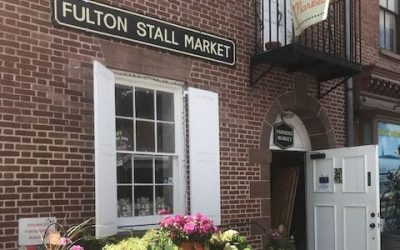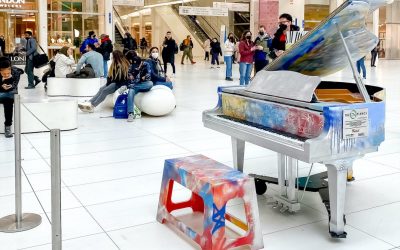Mayor Bloomberg always knew that Downtown would rise again.
Ever since taking office only months after the horrible devastation of 9/11, the newly minted Chief Executive of the City of New York made the rebuilding of the rubble that was once the area around the World Trade Center one of his administration’s priorities.
Shortly following his election just weeks after the attacks, Mayor Michael Bloomberg turned a horrific disaster into an opportunity, not only to rebuild…but also to improve Lower Manhattan. By the end of 2002, he had laid out the blueprint to turn all Lower Manhattan neighborhoods into a cohesive community that would be attractive to residential and commercial development.
The mayor worked closely with numerous state, federal and local officials and organizations to secure funding and, by 2005, joined with the Lower Manhattan Development Corporation and then-Governor George Pataki to reveal the wide array of specific target projects that would realize his vision for a greater Downtown.
Among his many areas of focus were the development of and access to the waterfront along both the East and Hudson rivers; funding for new schools; grants for streetscape improvements that enhanced security around Wall Street and the New York Stock Exchange; the redevelopment of Fulton Street as a commercial and transportation hub; the further develop ment of affordable housing in the area; and securing a place to pay homage to those we lost, with the World Trade Center memorial.
As the decade since the attacks has come to an end, most of the projects are well on their way to completion or have already been realized, attracting new residents and businesses, and making Downtown the fastest growing area in the city.
There is no one man more responsible for the spectacular revitalization of Lower Manhattan than this mayor…who recently took the time to share his passion for it and commitment to it with us.
How would you describe the task that was in front of you, and the rest of New York City, when you assumed office in the wake of the 9/11 attacks?
When I took office on January 1, 2002, the 9/11 attacks and the World Trade Center site were at the forefront of my mind. The tremendous task of removing the debris was already well underway, but now we faced an even more daunting task: what would we put where the Twin Towers once stood? Immediately, we focused efforts on beginning the process of honoring those we lost by soliciting designs for a memorial. We also recognized the tremendous impact this event had on Lower Manhattan, and we committed ourselves to helping to rebuild not only the World Trade Center, but also the Downtown community.
Were there moments when the task of selecting a design and rebuilding seemed insurmountable?
on the task of selecting a design for the memorial and committing to rebuilding on the site.
From what sources did you receive the most guidance and support when you took on the task of rebuilding the communities around Ground Zero?
As we approach the opening of the memorial on September 11, 2011, we’re thankful for the families of victims, survivors, community leaders, architects, developers and countless New Yorkers who came together in the wake of 9/11 to support this neighborhood. Today, not only are we about to open the most important memorial in recent history, but One World Trade Center is also already soaring above the rest of Downtown’s skyscrapers, people have stayed in their homes, more New Yorkers are moving to Lower Manhattan and businesses in all sectors are thriving Downtown.
What was the most difficult challenge you, as a new mayor, faced when confronted with such an unprecedented and polarizing situation?
Knowing that the construction of the World Trade Center had been such a polarizing issue leading up to the reconstruction of the Twin Towers, we faced the added challenge of finding a design that would both pay tribute to the lives of those we lost on 9/11 and also symbolize our strength and ability to rebuild.
What were the most difficult challenges in coordinating the activities and response of all the different city, state and federal agencies that had to work together to rebuild the area?
The stakeholders involved in the rebuilding are numerous—the Port Authority governors from both New York and New Jersey, Silverstein, the 9/11 families and the Lower Manhattan community. Every stakeholder has an opinion or a priority. The challenge with the rebuilding is that these opinions and priorities don’t always align. However, I think we all agree that it was necessary for the memorial to open in time for the 10th anniversary. Because of this shared commitment, we are realizing this goal.
Can you identify what you believe have been the most positive developments that have arisen from this horrific disaster?
I think it’s safe to say that Lower Manhattan is a much more vibrant neighborhood now than it was before 9/11. Being so close to tragedy and loss really brought this community together, and its strength and staying power has encouraged more businesses to flock to Downtown to establish offices, restaurants, arts organizations and family businesses. There is truly no better time to live, work or visit Lower Manhattan than now.
When did you start to believe that the city had turned the corner and your vision for what this area is about to become was going to be a reality?
I saw this spirit on September 12, 2001. People from throughout the five boroughs and far beyond flocked to the World Trade Center site to offer assistance and support to those in need. From the people donating blood to the recovery workers continuing their clean-up efforts, knowing that New Yorkers were committed to each other and committed to our city gave me all the assurance I needed that we would rebuild, and we would rebuild something as tremendous as the World Trade Center Memorial and Museum.
Did you ever foresee a time when so many major media companies would choose to move to Lower Manhattan or that there would be a magazine like DOWNTOWN, which was created specifically to promote the renaissance of this community?
There was no doubt in my mind that Lower Manhattan would not only recover, but also flourish during this period of revitalization. Even just in the area surrounding City Hall, we’ve seen tremendous architectural feats like Frank Gehry’s Beekman, local businesses like J&R and world-class education institutions like Pace continue to thrive in Downtown. And now there’s a magazine to cover it all—you have a front-row seat to watch history being made!
Can you address the genesis of the new marketing campaign to promote Lower Manhattan?
Again, I feel like this tags along with the need to rebuild after 9/11.
Describe the character of the community and its ability to bounce back like this.
I’ve always known that New Yorkers are tough, but I don’t think anyone realized how tough until 9/11. In the days, weeks and years that have followed, this community has come together to aid in the revitalization of its neighborhood, proving that the bonds that connect us all are much stronger than the things that divide us.
What do you think Downtown will be like a decade from now?
A decade from now, the rebuilding of the World Trade Center will be complete, and in addition to the already outstanding resources Downtown currently has, there will be a stunning and functional transportation hub, the tallest building in the United States and a solemn and beautiful new outdoor space to honor those we lost on September 11. I think we’ll have made even greater strides in showing that Lower Manhattan is a tremendous economic center, tourism mecca, and, most importantly, a terrific place to raise a family.
-by Mike Hammer













